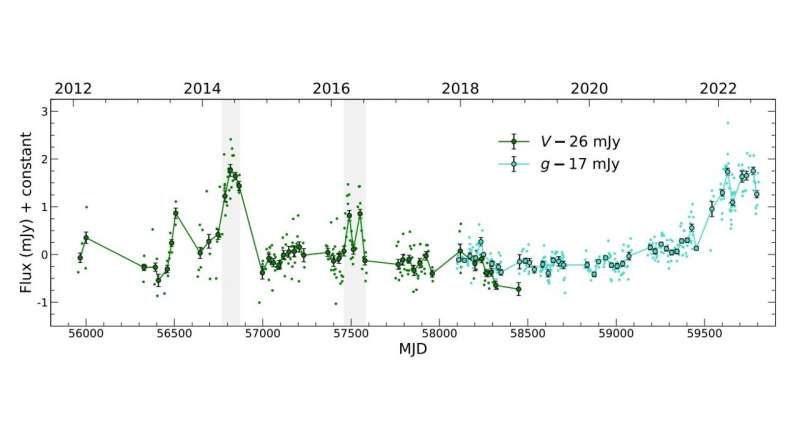November 17, 2022 report
Changing-look events observed in the galaxy NGC 5273

Astronomers have analyzed new and archival multiwavelength observations of the active galaxy NGC 5273. As a result, they detected so-called "changing-look" events in the active galactic nucleus of this galaxy. The finding is reported in a paper published November 7 on arXiv.org.
An AGN is a compact region at the center of a galaxy, more luminous than the surrounding galaxy light. They are very energetic due either to the presence of a black hole or star formation activity at the core of the galaxy.
Astronomers generally divide AGNs into two groups based on emission line features. Type 1 AGNs show broad and narrow emission lines, while only narrow emission lines are present in Type 2 AGNs. However, observations revealed that some AGNs transition between different spectral types; therefore, they were dubbed changing-look (CL) AGNs.
At a distance of some 53.8 million light years, NGC 5273 is a Syefert galaxy hosting a low-luminosity variable AGN. The active galactic nucleus of NGC 5273 is relatively dim compared to other AGNs. Previous observations of this galaxy revealed that it began to steadily increase in brightness in late 2021, peaking in 2022.
Now, a team of astronomers led by Jack M.M. Neustadt of the Ohio State University in Columbus, Ohio, reports the detection of new changing-look behavior of the AGN in NGC 5273. The finding is a result of a detailed analysis of a vast set of infrared, optical, ultraviolet, and X-ray data acquired by various spacecraft and ground-based telescopes.
The study conducted by Neustadt's team found that at least one changing-look event took place in NGC 5273. The AGN changed from a Type 1.8/1.9 Seyfert to a Type 1 where broad optical and near-infrared emission lines appear in the spectra, making the active galactic nucleus of NGC 5273 one of the few AGNs known to change-look in infrared.
The data show that the changing-look event in NGC 5273 is coincident in time with a flare of AGN that occurred in 2014, and with evidence for historical variability prior to 2000. These findings suggest that the other flares in this galaxy may have been also temporary changing-look events from a baseline Type 1.8/1.9 into Type 1.
In general, the study found that the AGN of NGC 5273 varies by factors of 2 to 10 in infrared to X-ray flux, with short flares in 2002, 2014, 2016, and a long ongoing flare that commenced in late 2021.
Summing up the results, the researchers concluded that the changing-look events in NGC 5273 are likely due to changes in how the broad line region (BLR) reprocesses the continuum emission as evidenced by the changing Eddington ratio, Balmer decrement, and emergent broad near-infrared emission lines.
"Changes in the wind due to changes in λEdd could thus lead to changes in the BLR, though it is unclear how this would specifically affect the Balmer decrement or the NIR broad lines," the authors of the paper explained.
More information: J. M. M. Neustadt et al, Once is an Instance, Twice is a Hobby: Multiple Optical and Near-Infrared Changing-Look Events in NGC 5273, arXiv (2022). DOI: 10.48550/arxiv.2211.03801
Journal information: arXiv
© 2022 Science X Network



















